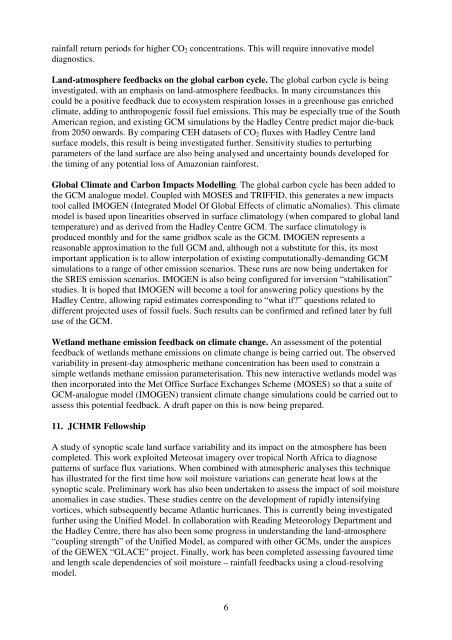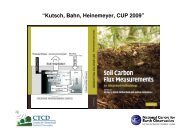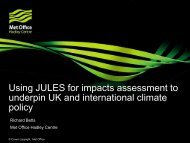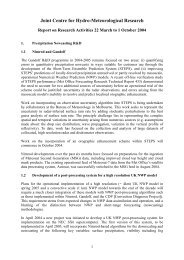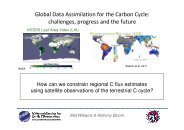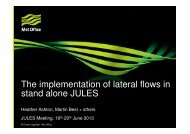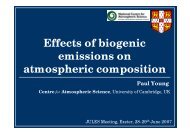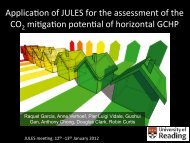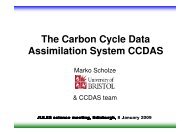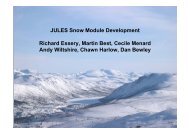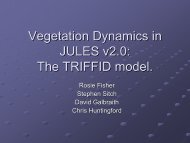here in PDF format - Joint Centre for Hydro-Meteorological Research
here in PDF format - Joint Centre for Hydro-Meteorological Research
here in PDF format - Joint Centre for Hydro-Meteorological Research
Create successful ePaper yourself
Turn your PDF publications into a flip-book with our unique Google optimized e-Paper software.
a<strong>in</strong>fall return periods <strong>for</strong> higher CO 2 concentrations. This will require <strong>in</strong>novative model<br />
diagnostics.<br />
Land-atmosp<strong>here</strong> feedbacks on the global carbon cycle. The global carbon cycle is be<strong>in</strong>g<br />
<strong>in</strong>vestigated, with an emphasis on land-atmosp<strong>here</strong> feedbacks. In many circumstances this<br />
could be a positive feedback due to ecosystem respiration losses <strong>in</strong> a greenhouse gas enriched<br />
climate, add<strong>in</strong>g to anthropogenic fossil fuel emissions. This may be especially true of the South<br />
American region, and exist<strong>in</strong>g GCM simulations by the Hadley <strong>Centre</strong> predict major die-back<br />
from 2050 onwards. By compar<strong>in</strong>g CEH datasets of CO 2 fluxes with Hadley <strong>Centre</strong> land<br />
surface models, this result is be<strong>in</strong>g <strong>in</strong>vestigated further. Sensitivity studies to perturb<strong>in</strong>g<br />
parameters of the land surface are also be<strong>in</strong>g analysed and uncerta<strong>in</strong>ty bounds developed <strong>for</strong><br />
the tim<strong>in</strong>g of any potential loss of Amazonian ra<strong>in</strong><strong>for</strong>est.<br />
Global Climate and Carbon Impacts Modell<strong>in</strong>g. The global carbon cycle has been added to<br />
the GCM analogue model. Coupled with MOSES and TRIFFID, this generates a new impacts<br />
tool called IMOGEN (Integrated Model Of Global Effects of climatic aNomalies). This climate<br />
model is based upon l<strong>in</strong>earities observed <strong>in</strong> surface climatology (when compared to global land<br />
temperature) and as derived from the Hadley <strong>Centre</strong> GCM. The surface climatology is<br />
produced monthly and <strong>for</strong> the same gridbox scale as the GCM. IMOGEN represents a<br />
reasonable approximation to the full GCM and, although not a substitute <strong>for</strong> this, its most<br />
important application is to allow <strong>in</strong>terpolation of exist<strong>in</strong>g computationally-demand<strong>in</strong>g GCM<br />
simulations to a range of other emission scenarios. These runs are now be<strong>in</strong>g undertaken <strong>for</strong><br />
the SRES emission scenarios. IMOGEN is also be<strong>in</strong>g configured <strong>for</strong> <strong>in</strong>version “stabilisation”<br />
studies. It is hoped that IMOGEN will become a tool <strong>for</strong> answer<strong>in</strong>g policy questions by the<br />
Hadley <strong>Centre</strong>, allow<strong>in</strong>g rapid estimates correspond<strong>in</strong>g to “what if?” questions related to<br />
different projected uses of fossil fuels. Such results can be confirmed and ref<strong>in</strong>ed later by full<br />
use of the GCM.<br />
Wetland methane emission feedback on climate change. An assessment of the potential<br />
feedback of wetlands methane emissions on climate change is be<strong>in</strong>g carried out. The observed<br />
variability <strong>in</strong> present-day atmospheric methane concentration has been used to constra<strong>in</strong> a<br />
simple wetlands methane emission parameterisation. This new <strong>in</strong>teractive wetlands model was<br />
then <strong>in</strong>corporated <strong>in</strong>to the Met Office Surface Exchanges Scheme (MOSES) so that a suite of<br />
GCM-analogue model (IMOGEN) transient climate change simulations could be carried out to<br />
assess this potential feedback. A draft paper on this is now be<strong>in</strong>g prepared.<br />
11. JCHMR Fellowship<br />
A study of synoptic scale land surface variability and its impact on the atmosp<strong>here</strong> has been<br />
completed. This work exploited Meteosat imagery over tropical North Africa to diagnose<br />
patterns of surface flux variations. When comb<strong>in</strong>ed with atmospheric analyses this technique<br />
has illustrated <strong>for</strong> the first time how soil moisture variations can generate heat lows at the<br />
synoptic scale. Prelim<strong>in</strong>ary work has also been undertaken to assess the impact of soil moisture<br />
anomalies <strong>in</strong> case studies. These studies centre on the development of rapidly <strong>in</strong>tensify<strong>in</strong>g<br />
vortices, which subsequently became Atlantic hurricanes. This is currently be<strong>in</strong>g <strong>in</strong>vestigated<br />
further us<strong>in</strong>g the Unified Model. In collaboration with Read<strong>in</strong>g Meteorology Department and<br />
the Hadley <strong>Centre</strong>, t<strong>here</strong> has also been some progress <strong>in</strong> understand<strong>in</strong>g the land-atmosp<strong>here</strong><br />
“coupl<strong>in</strong>g strength” of the Unified Model, as compared with other GCMs, under the auspices<br />
of the GEWEX “GLACE” project. F<strong>in</strong>ally, work has been completed assess<strong>in</strong>g favoured time<br />
and length scale dependencies of soil moisture – ra<strong>in</strong>fall feedbacks us<strong>in</strong>g a cloud-resolv<strong>in</strong>g<br />
model.<br />
6


